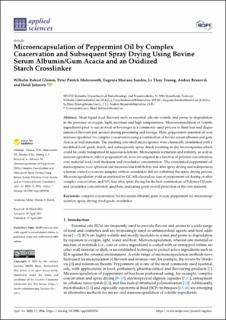| dc.contributor.author | Glomm, Wilhelm Robert | |
| dc.contributor.author | Molesworth, Peter Patrick | |
| dc.contributor.author | Sandru, Eugenia-Mariana | |
| dc.contributor.author | Truong, Thuy le | |
| dc.contributor.author | Brunsvik, Anders | |
| dc.contributor.author | Johnsen, Heidi | |
| dc.date.accessioned | 2022-10-10T07:36:50Z | |
| dc.date.available | 2022-10-10T07:36:50Z | |
| dc.date.created | 2021-09-21T13:39:29Z | |
| dc.date.issued | 2021 | |
| dc.identifier.citation | Applied Sciences. 2021, 11 (9), 1-12 | en_US |
| dc.identifier.issn | 2076-3417 | |
| dc.identifier.uri | https://hdl.handle.net/11250/3024906 | |
| dc.description.abstract | Most liquid food flavours such as essential oils are volatile and prone to degradation in the presence of oxygen, light, moisture and high temperatures. Microencapsulation of volatile ingredients prior to use in food or beverages is a commonly used process to limit loss and degradation of flavours and aromas during processing and storage. Here, peppermint essential oil was microencapsulated via complex coacervation using a combination of bovine serum albumin and gum Acacia as wall materials. The resulting core-shell microcapsules were chemically crosslinked with a modified food-grade starch, and subsequently spray dried, resulting in dry microcapsules which could be easily redispersed in aqueous solutions. Microcapsule formation and stability, as well as microencapsulation yield of peppermint oil, were investigated as a function of polymer concentration, core material load/wall thickness and crosslinker concentration. The crosslinked peppermint oil microcapsules were spherical and mononuclear both before and after spray drying and redispersion, whereas control coacervate samples without crosslinker did not withstand the spray drying process. Microencapsulation yield as analysed by GC-MS showed no loss of peppermint oil during or after complex coacervation, and 54% loss after spray drying for the best combination of Polymer:Oil ratio and crosslinker concentration used here, indicating good overall protection of the core material. | en_US |
| dc.language.iso | eng | en_US |
| dc.rights | Navngivelse 4.0 Internasjonal | * |
| dc.rights.uri | http://creativecommons.org/licenses/by/4.0/deed.no | * |
| dc.subject | food grade crosslinker | en_US |
| dc.subject | spray drying | en_US |
| dc.subject | microencapsulation | en_US |
| dc.subject | peppermint oil | en_US |
| dc.subject | gum Acacia | en_US |
| dc.subject | bovine serum albumin | en_US |
| dc.subject | complex coacervation | en_US |
| dc.title | Microencapsulation of Peppermint Oil by Complex Coacervation and Subsequent Spray Drying Using Bovine Serum Albumin/Gum Acacia and an Oxidized Starch Crosslinker | en_US |
| dc.type | Peer reviewed | en_US |
| dc.type | Journal article | en_US |
| dc.description.version | publishedVersion | en_US |
| dc.rights.holder | Copyright: © 2021 by the authors. Licensee MDPI, Basel, Switzerland. This article is an open access article distributed under the terms and conditions of the Creative Commons Attribution (CC BY) license (https:// creativecommons.org/licenses/by/ 4.0/). | en_US |
| dc.source.pagenumber | 12 | en_US |
| dc.source.volume | 11 | en_US |
| dc.source.journal | Applied Sciences | en_US |
| dc.source.issue | 9 | en_US |
| dc.identifier.doi | 10.3390/app11093956 | |
| dc.identifier.cristin | 1936586 | |
| cristin.ispublished | true | |
| cristin.fulltext | original | |
| cristin.qualitycode | 1 | |

